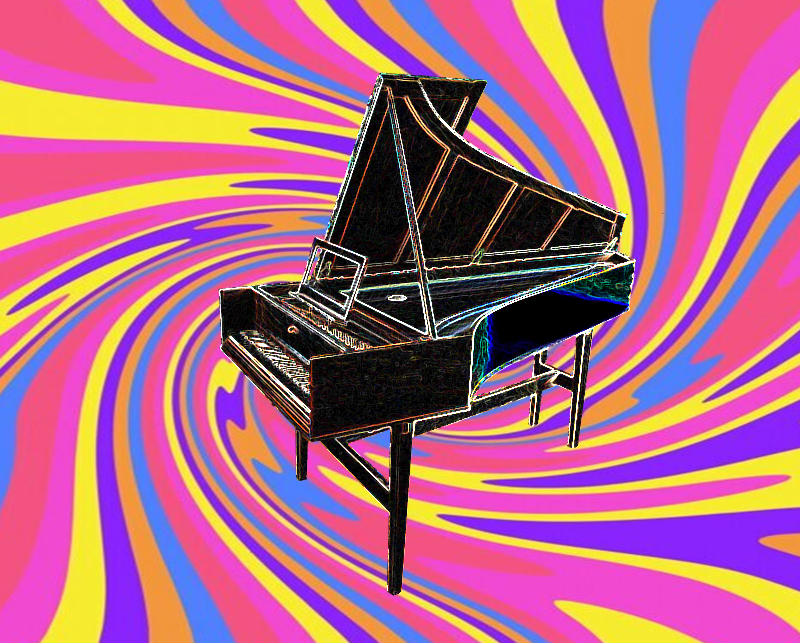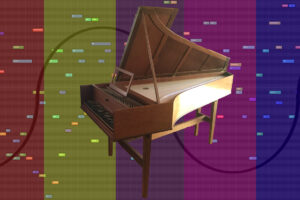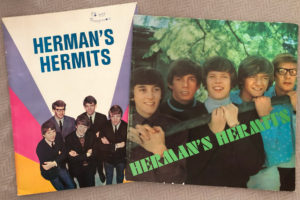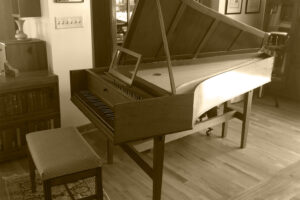In the 1940s and 1950s (outside of classical music) the harpsichord had been more or less a prop or novelty instrument in jazz and popular music. During the 1960s, the harpsichord became an unlikely star. It was everywhere and in all kinds of music—from TV and movie themes, to jazz, country, soul, easy listening, and of course pop . . . especially Baroque Pop and psychedelia. This blog is the second in a series that explores the use of harpsichord in popular music. (Part 1 here.)
Why the harpsichord? Perhaps at a time when youth were demanding to be taken seriously, the use of this Renaissance instrument was a conscious bid to capitalize on its associations with “serious music.” Another reason could be that in the 1960s, new sounds were being actively introduced—from distortion pedals, feedback, sitars from India, and various electronics. The harpsichord blended into this mosaic of newness and exotica.
The introduction in 1960 of a build-at-home harpsichord kit made the instrument affordable. It was developed by Manhattan-based amateur musician and harpsichord maker Wolfgang Zuckermann. A simple model sold for $150—not including the plywood.
In the mid-1960s a genre or style of music developed that was called Baroque Pop or Baroque Rock. It combined rock music with elements of classical music—such as contrapuntal melodies and functional harmony patterns. Harpsichords figured prominently as well as oboes, French horns, and string quartets. A slightly later development is referred to as psychedelic Baroque Pop.
During the 1960s rock groups often recorded albums using studio musicians. A group of session musicians in Los Angeles called The Wrecking Crew regularly used harpsichord in the arrangements. The keyboard players (who also played harpsichord) were Larry Knechtel, Michel Rubini, Mike Melvoin, Al De Lory, and Don Randi.
The harpsichord is a versatile instrument. It can be used like a rhythm guitar and remain in the background or it can come forward in the mix. With its distinctive timbre, it can pierce through a wall of sound and provide interesting counter-melodies.
TV and Movie Themes
The harpsichord is prominently featured in the TV themes, The Avengers and The Addams Family—both from the 1960s.
The score to the 1969 film La Horse uses harpsichord. The soundtrack was written by Serge Gainsbourg and arranged by Jean-Claude Vannier. John Barry uses harpsichord in the title theme “Back to Nature” to the 1971 movie Walkabout.
Songs from the 1960s that Use Harpsichord
Arbors
“The Letter” (1969)
Association, The
“We Love Us” (1967) Larry Knechtel plays the harpsichord.
“Windy” (1967)
Beach Boys, The
“When I Grow Up to Be a Man” (1965) Listen closely and you can hear the harpsichord figurations throughout.
“You Still Believe in Me” (1966) From the album, Pet Sounds. Al DeLory is playing harpsichord. The introduction is a series of plucked piano strings. Harpsichord is used during the song.
“God Only Knows” (1966) From the album, Pet Sounds. Larry Knechtel is playing the harpsichord.
“I Just Wasn’t Made for These Times” (1966) From the album, Pet Sounds. Mike Melvoin is playing harpsichord.
“Caroline, No” (1966) From the album, Pet Sounds. Al De Lory, is playing harpsichord and using the lute stop on the harpsichord.
https://www.youtube.com/watch?v=4OCja0WBWYA
Beatles, The
“All You Need Is Love” (1967) John Lennon plays harpsichord as well as banjo on this track.
“Because” (1969) The song begins with an electric harpsichord intro played by George Martin. It is also one of the few Beatles recordings to feature a Moog synthesizer which is played by George Harrison.
“Fixing a Hole” (1967) The distinctive intro on this song is played on a harpsichord.
https://www.youtube.com/watch?v=UPBd8eHQqIw
“In My Life” (1965) inspired pop music producers to use harpsichords in their arrangements. In the instrumental bridge the instrument sounds similar to a harpsichord. However, George Martin wrote a Bach-influenced interlude and recorded it half-speed on the piano. When played back at normal speed, it sounds an octave higher giving it a unique timbre, similar to a harpsichord.
“Piggies” (1968) The track features harpsichord and strings in the Baroque Pop style. Chris Thomas is playing the harpsichord.
Bee Gees
“Turn of the Century” (1967) A whimsical Baroque epic song, it uses harpsichord along with lush orchestration and classic vocals from the Gibbs.
Brenda Lee
“All Alone Am I” (1962)
Buckinghams, The
“Have You Noticed You’re Alive” (1967) The dissonant harpsichord at the opening evolves into a dreamy, rich string section.
Cher
“Bang Bang (My Baby Shot Me Down)” (1966)
“I Go To Sleep” (1965)
Deep Purple
“Blind” (1969)
Dillard and Clark
“In The Plan” (1968)
“The Radio Song” (1968)
“With Care From Someone” (1968)
Donovan
“Epistle to Dippy” (1967)
“Sunshine Superman” (1966)
https://www.youtube.com/watch?v=YsX2FhBf9nY
Doors, The
“Love Her Madly” (1971)
“Love Me Two Times” (1967) Ray Manzarek is playing harpsichord.
https://www.youtube.com/watch?v=AVez4RS7IJw
“Shaman’s Blues” (1969) Ray Manzarek is playing harpsichord.
“The Soft Parade” (1969) Ray Manzarek is playing harpsichord.
“Touch Me” (1969) Ray Manzarek is playing harpsichord.
“Wintertime Love” (1968) Ray Manzarek is playing the harpsichord.
Elton John
“I Need You To Turn To” (1970)
https://www.youtube.com/watch?v=6L1VfkUYSTo
“Skyline Pigeon” (1969) The original version features Elton John playing harpsichord.
https://www.youtube.com/watch?v=iRFGgr4XIos
Everly Brothers, The
“Nancy’s Minuet” (1963, released 1977)
Gale Garnett
“We’ll Sing In the Sunshine” (1964)
Gary Lewis & The Playboys
“Everybody Loves a Clown” (1965)
“My Heart’s Symphony” (1966) was written by Glen Hardin and was on the album, (You Don’t Have To) Paint Me a Picture. Glen Hardin and Leon Russell wrote the arrangements. This arrangement is particularly nice and the harpsichord is stunning on this track!
https://www.youtube.com/watch?v=r9x0unW0X8A
“She’s Just My Style” (1966)
Gentle Soul
“Reelin’” (1968) Gentle Soul was a folk band formed in 1966. The group centered around the duo Pamela Polland and Rick Stanley. Inspired by their interest in meditation, metaphysics, and spiritual exploration, they recorded on the cutting edge of the Folk/Rock Era for the next three years. This track is from their only album. The album uses interesting orchestral instrumentation including harpsichord, flute, and cello. Their recordings have become coveted classics with the original vinyl album being a pricey collector’s item.
Gladys Knight and The Pips
“Take Me in Your Arms and Love Me” (1967)
Grass Roots, The
“Where Were You When I Needed You” (1966) Larry Knechtel is playing the harpsichord.
Grateful Dead, The
“Mountains of the Moon” (1969) This song seeks to capture the sound of ancient folk songs with the simple guitar picking and the harpsichord figures. Tom Constanten is playing the harpsichord.
https://www.youtube.com/watch?v=O0tgkDTjpwE
Harry Nilsson
“One (Is the Loneliest Number)” (1969) by Harry Nilsson was a huge hit for Three Dog Night in 1969. Nilsson wrote the song after calling someone and getting a busy signal. He stayed on the line listening to the beep, beep, beep . . . The busy signal became the opening notes of the song. You can hear harpsichord in Nilsson’s version beginning about a minute into the song.
Herman’s Hermits
“Show Me Girl” (1965)
Janis Ian
“Society’s Child” (1966)
Jason Kaye
“Land of Sensations & Delights” (1968) is from Suddenly One Summer by J.K. & Co. This album fits into the genre of soft psychedelic rock. It was the conception of fifteen-year-old Jay Kaye. Some of the songs were played on California free-form radio stations. But apart from that, the album vanished quickly from the radar. Kaye had another song with harpsichord that was released on a compilation album of various artists in 2004. The song is “Little Children” and is on the album, Out of Nowhere: The White Whale Story (Vol. 2). The artist is listed as Jason Kaye & Co.
John D. Loudermilk
“Language of Love” (1961)
Jimi Hendrix
“The Burning of the Midnight Lamp” (1967) (alternate version) by Jimi Hendrix was performed by English-American rock trio the Jimi Hendrix Experience. Jimi is playing the harpsichord. He is quoted as saying he “can’t play no piano or harpsichord, just picked out different little notes and started from there.”
Judy Collins
“Hard Lovin’ Loser” (1966) is from her album, In My Life. Joshua Rifkin made the arrangements on this album. Judy Collins is listed as playing keyboards.
“Both Sides, Now” (1967) was written by Joni Mitchell. It was first recorded by Judy Collins and became one of her signature songs.
Kinks, The
“Rosie Won’t You Please Come Home” (1966)
“Session Man” (1966) This song is an homage to the often-overlooked session musician who is “not paid to think, just play.” It was partly inspired by English pianist Nicky Hopkins who played with The Who, The Rolling Stones, and Led Zeppelin. Hopkins plays the harpsichord at the beginning of this track.
“Some Mother’s Son” (1969) Ray Davies plays the harpsichord.
“Too Much On My Mind” (1966) Nicky Hopkins is playing harpsichord.
“Two Sisters” (1967)
“Village Green” (1968)
https://www.youtube.com/watch?v=320yV68ab5c
Left Banke
“Walk Away Renée” (1966) was written by Michael Brown, Bob Calilli, and Tony Sansone. Michael Brown is playing harpsichord. This song is probably the first Baroque Pop song and to give it the right sound, they used a harpsichord. The arrangement also includes lush strings and a notable flute solo during the instrumental bridge.
https://www.youtube.com/watch?v=qDfrW5cWqMU
Lemon Pipers, The
“Rainbow Tree” (1968)
“Rice is Nice” (1968)
Lesley Gore
“Judy’s Turn To Cry” (1963)
https://www.youtube.com/watch?v=mw9ZQVFS-vA
Linda Ronstadt
“Different Drum” (1967) was written by Michael Nesmith (of the Monkees) in 1964 when he wanted to start performing as a singer-songwriter. The song became popular in 1967 when the Stone Poneys recorded it featuring Linda Ronstadt. The album version has a longer harpsichord bridge than the single version. The harpsichord is played by Don Randi.
https://www.youtube.com/watch?v=o4G0YIW6N5A
Love
“Seven and Seven Is” (1966)
“She Comes in Colours” (1966) The harpsichord is played by Alban “Snoopy” Pfisterer.
“Stephanie Knows Who” (1966) AllMusic critic Matthew Greenwald describes the song as a “combination of hard, psychedelic rock with a free jazz interlude.” The song has also been described as “wonderfully quirky,” and “among the most attractively sophisticated of the era.” Alban “Snoopy” Pfisterer is playing harpsichord.
“The Red Telephone” (1967) Don Randi plays harpsichord on this track.
Mamas & the Papas, The
“Monday, Monday” (1966)
“Frustration” (1967) This delightful instrumental track was written by John Phillips and is on their album, Deliver. The harpsichord is played by Larry Knechtel.
Mandolph, Margaret
“If You Ever Need Me” (1964)
Mason Williams
“Baroque-A-Nova” (1968) by Mason Williams is on his album, The Mason Williams Phonograph Record. He is best known for the song “Classical Gas” from this same album.
Monkees, The
“I Wanna Be Free” (1966) was written by Tommy Boyce and Bobby Hart. The instrumentation uses string quartet, acoustic guitar, and harpsichord. Michel Rubini is playing harpsichord.
“The Girl I Knew Somewhere” (1967) was written by Michael Nesmith. The song was first released as the B-side to “A Little Bit Me, a Little Bit You.” It was recorded as they finally achieved the independence that allowed them to produce and perform their own material. The actual band members are featured on both vocals and instrumental arrangements. Peter Tork is playing harpsichord.
Move, The
“Blackberry Way” (1968) This song was their most successful single reaching number one on the UK Singles Chart in February 1969. Richard Tandy who later played keyboards with the “Electric Light Orchestra” plays harpsichord on this song. The song was written by Roy Wood and is inspired by the Beatles’ “Penny Lane.”
Nazz
“Forget All About It” (1969) was on the second studio album, Nazz Nazz by the American rock band Nazz. The songwriter-guitarist for the group at that time was Todd Rundgren. He played guitar, keyboards, and did vocals as well as wrote horn and string arrangements. This song was the opening track on the album and is high energy with massed vocal choruses. You can’t hear the harpsichord until later in the song.
Nancy Sinatra
“Sugar Town” (1966)
Paul Mauriat
“Love Is Blue” (1967) is a song by Andre Popp with lyrics by Pierre Cour. There have been many versions, but one of the most popular was French orchestra leader Paul Mauriat’s instrumental version. This arrangement is one of the touchstones of 1960s easy listening.
Paul Revere and the Raiders
“All About Her” (1966) is unusual in that it uses the buff stop on the harpsichord. The buff stop mutes the tone by lightly pressing a piece of buff leather or felt against the strings near the nut. It has the effect of damping the vibrations, especially the high harmonics. The sound takes on a duller, pizzicato quality.
https://www.youtube.com/watch?v=LfKrg3ATf84
“B.F.D.R.F. Blues” (1966) was a bonus track on the Paul Revere & The Raiders’ album, Just Like Us! The album was released after the group began appearing regularly on the TV variety show Where the Action Is. The harpsichord was left over from a classical session, so the band chose to use it.
Peter and Gordon
“Sunday for Tea” (1967)
Richard Harris
“MacArthur Park” (1968) was written by Jimmy Webb. Richard Harris was the first to record this song. Harris recorded the track in Hollywood and used members of the Wrecking Crew. However, Jimmy Webb played the harpsichord on this song.
Rolling Stones, The
“Citadel” (1967) from the album, Their Satanic Majesties Request was written by Mick Jagger and Keith Richards. The album’s title is a play on the “Her Britannic Majesty requests and requires . . .” text that appears inside a British passport. This album experiments with a psychedelic sound. Nicky Hopkins is playing harpsichord.
“Dandelion” (1967) was written by Mick Jagger and Keith Richards. It was first released as a B-side to “We Love You.” Nicky Hopkins is playing harpsichord.
“In Another Land” (1967) from the album, Their Satanic Majesties Request was written by bassist Bill Wyman. This is the only Rolling Stones song to feature Wyman on lead vocals. Nicky Hopkins is playing harpsichord.
“Lady Jane” (1966) was written by Mick Jagger and Keith Richards. It is on the Rolling Stones’ album, Aftermath. The song showcases Brian Jones’ use of Baroque Rock orchestration. Also, Jones plays dulcimer on this track which gives a nod toward world music. Jack Nitzsche is playing harpsichord.
https://www.youtube.com/watch?v=WBgMUDj9wfM
“Play with Fire” (1965) was the B-side to their song, “The Last Time.” It was recorded in January 1965 while the Stones were in Los Angeles recording with Phil Spector at RCA Studios. Jack Nitzsche played the harpsichord. In this early recording of the Rolling Stones, Mick Jagger’s voice is more melodious and lyrical than his voice sounds in later recordings.
https://www.youtube.com/watch?v=78ez5GurfWw
“Ride On, Baby” (1967) Brian Jones is playing harpsichord.
“Sittin’ On a Fence” (1965-67) Brian Jones is playing harpsichord.
“Yesterday’s Papers” (1967) is on the album, Between the Buttons. It was the first song that Mick Jagger wrote by himself for the group. Brian Jones is playing vibraphone and Jack Nitzsche is on harpsichord.
Seekers, The
“All I Can Remember” (1967)
Sergio Mendes & Brasil ‘66
“Slow Hot Wind” (1966)
Simon & Garfunkel
“Leaves that are Green” (1966) is considered among the best of the Simon and Garfunkel songs. The song has a light, breezy feel, with nice chord changes and beautiful harmonies.
“Scarborough Fair/Canticle” (1966) is a traditional ballad from the 16th century and is arranged by Simon & Garfunkel for their third studio album, Parsley, Sage, Rosemary and Thyme. This track uses fingerpicked guitar accompaniment, delicate chimes, harpsichord, and their signature vocal harmonies. John Meszar is playing the harpsichord on this track. The harpsichord is essential to driving the rhythm and setting the mood for this song.
Spirit
“Taurus” (1968) is a rock instrumental written by Spirit guitarist/singer Randy California. It was released on their debut album, Spirit. There has been some controversy surrounding the track. It has been alleged that Jimmy Page borrowed the descending guitar figure from “Taurus” and used it in Led Zeppelin’s signature song, “Stairway to Heaven.” Led Zeppelin had opened for Spirit in an early tour in America . . . providing the possibility that Led Zeppelin had heard the song before writing “Stairway to Heaven.” Randy died in 1997. In 2014, his estate filed a copyright infringement suit seeking a co-writing credit for Randy on “Stairway to Heaven.” The courts eventually ruled in favor of Led Zeppelin. I think the instrumental track “Taurus” is lovely and the harpsichord adds just the right touch.
Steppenwolf
“A Girl I Knew” (1968)
https://www.youtube.com/watch?v=eADTnNkMd-w
Steve Miller Band
“Baby’s Callin’ Me Home” (1968) was on their debut album, Children of the Future. Ben Sidran is playing the harpsichord.
Supremes, The
“Love Is Here and Now You’re Gone” (1967) was recorded by The Supremes for the Motown label. The track features harpsichord and strings which are similar to The Left Banke’s popular Baroque Rock style.
“The Happening” (1967) was the theme song of the Columbia movie, The Happening. The song was released as a single at the time of the film’s release. The movie flopped but the song peaked at number one on the Billboard Hot 100 pop singles chart in May 1967.
https://www.youtube.com/watch?v=eLVxddcrod8
Temptations, The
“Message from a Black Man” (1969)
Traffic
“Hope I Never Find Me There” (1967) is on their debut album, Mr. Fantasy. Members of this English rock band were Steve Winwood, Jim Capaldi, Chris Wood, and Dave Mason. Steve Winwood plays harpsichord on this track.
Vanity Fare
“Early in the Morning” (1969)
Van Morrison
“Cyprus Avenue” (1968) The song is built on a basic blues structure and can be described as “a chamber-music hybrid of folk-blues, jazz, and classical music. Larry Fallon is playing harpsichord.
https://www.youtube.com/watch?v=L8jPDdHd9y8
“Everyone” (1970) from his album, Moondance, uses clavinet which is similar to the harpsichord. It is used in the introduction.
West Coast Pop Art Experimental Band, The
“Transparent Day” (1967) The West Coast Pop Art Experimental Band was an American psychedelic rock band formed in Los Angeles in 1965. The song was written by Bob Markley and Dan Harris.
Who, The
“I Need You” (1966) by Keith Moon is on The Who’s second album, A Quick One. As the result of a publishing deal, Moon, who had never written a song before was required to come up with two tunes for this album. The original title was “I Need You (Like I Need A Hole in The Head).” The spoken part in the interlude during the harpsichord solo is meant to imitate (or mock) the Beatles. John Entwistle is playing harpsichord.
Wynder K. Frog
“Harpsichord Shuffle” (1967) from the album, Sunshine Super Frog features Mick Weaver as Wynder K. Frog. All the tracks feature Weaver backed by unnamed session musicians from New York City.
Yardbirds, The
“For Your Love” (1965) This song was a change from the group’s blues roots in favor of a more commercial pop rock sound. Guitarist Eric Clapton did not like the change and left the group on the day this song went public. The song was written by Graham Gouldman who also wrote hit songs for Herman’s Hermits and the Hollies. Session musician Brian Auger played harpsichord. He is quoted as saying, “Who, in their right mind is going to buy a pop single with harpsichord on it?” Apparently, Brian walked into the session and realized there was no organ or piano in the studio. However, there was a harpsichord!
https://www.youtube.com/watch?v=yKI7c9x2lbM
Zombies, The
“Imagine the Swan” (1969) Rod Argent was one of the main composers of the Zombies’ songs and he played keyboard using a variety of instruments, including the Mellotron, the harpsichord, and the organ.
Use of Harpsichord in the 1970s
In my next blog, “Use of Harpsichord in Popular Music: Part 3,” I will list music from the 1970s that uses harpsichord. Diverse artists such as Tom Waits, Barry White, Fleetwood Mac, Jimmy Buffett, and others used harpsichord.
Do you know other songs from the 1960s that use harpsichord? List them in the comments below!










Leave a Reply
Your email is safe with us.